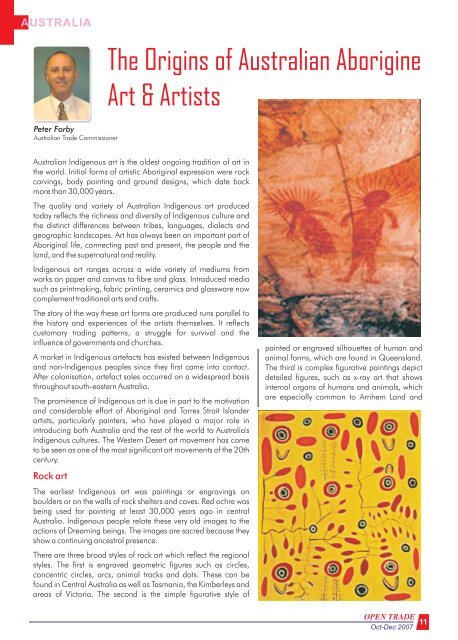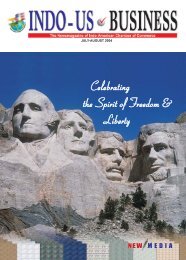pele SciaSction - new media
pele SciaSction - new media
pele SciaSction - new media
Create successful ePaper yourself
Turn your PDF publications into a flip-book with our unique Google optimized e-Paper software.
AUSTRALIA<br />
Peter Forby<br />
Australian Trade Commissioner<br />
The Origins of Australian Aborigine<br />
Art & Artists<br />
Australian Indigenous art is the oldest ongoing tradition of art in<br />
the world. Initial forms of artistic Aboriginal expression were rock<br />
carvings, body painting and ground designs, which date back<br />
more than 30,000 years.<br />
The quality and variety of Australian Indigenous art produced<br />
today reflects the richness and diversity of Indigenous culture and<br />
the distinct differences between tribes, languages, dialects and<br />
geographic landscapes. Art has always been an important part of<br />
Aboriginal life, connecting past and present, the people and the<br />
land, and the supernatural and reality.<br />
Indigenous art ranges across a wide variety of mediums from<br />
works on paper and canvas to fibre and glass. Introduced <strong>media</strong><br />
such as printmaking, fabric printing, ceramics and glassware now<br />
complement traditional arts and crafts.<br />
The story of the way these art forms are produced runs parallel to<br />
the history and experiences of the artists themselves. It reflects<br />
customary trading patterns, a struggle for survival and the<br />
influence of governments and churches.<br />
A market in Indigenous artefacts has existed between Indigenous<br />
and non-Indigenous peoples since they first came into contact.<br />
After colonisation, artefact sales occurred on a widespread basis<br />
throughout south-eastern Australia.<br />
The prominence of Indigenous art is due in part to the motivation<br />
and considerable effort of Aboriginal and Torres Strait Islander<br />
artists, particularly painters, who have played a major role in<br />
introducing both Australia and the rest of the world to Australia's<br />
Indigenous cultures. The Western Desert art movement has come<br />
to be seen as one of the most significant art movements of the 20th<br />
century.<br />
Rock art<br />
The earliest Indigenous art was paintings or engravings on<br />
boulders or on the walls of rock shelters and caves. Red ochre was<br />
being used for painting at least 30,000 years ago in central<br />
Australia. Indigenous people relate these very old images to the<br />
actions of Dreaming beings. The images are sacred because they<br />
show a continuing ancestral presence.<br />
There are three broad styles of rock art which reflect the regional<br />
styles. The first is engraved geometric figures such as circles,<br />
concentric circles, arcs, animal tracks and dots. These can be<br />
found in Central Australia as well as Tasmania, the Kimberleys and<br />
areas of Victoria. The second is the simple figurative style of<br />
painted or engraved silhouettes of human and<br />
animal forms, which are found in Queensland.<br />
The third is complex figurative paintings depict<br />
detailed figures, such as x-ray art that shows<br />
internal organs of humans and animals, which<br />
are especially common to Arnhem Land and<br />
OPEN TRADE 11<br />
Oct-Dec 2007

















